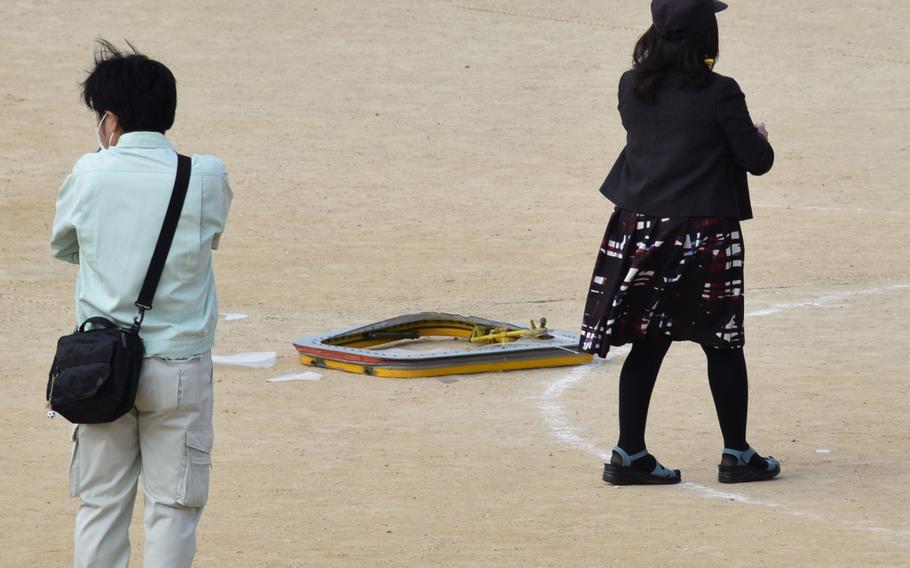Asia-Pacific
Window from Super Stallion lands on Okinawa elementary school's sports field
Stars and Stripes December 13, 2017

A window frame from a U.S. military aircraft lies on the ground at an elementary school in Ginowan, Okinawa on Wednesday, Dec. 13, 2017. Japanese officials say a boy was injured when the metal frame fell from a CH-53 helicopter. (AP)
CAMP FOSTER, Okinawa — A window from a Marine Corps CH-53E Super Stallion helicopter inexplicably fell from the sky Wednesday and landed on a field where schoolchildren were playing — the latest in a string of U.S. military aircraft mishaps on Okinawa.
The window hit the ground at about 10:10 a.m. at Futenma Daini Elementary School, which is next to the fence line on the northern side of Marine Corps Air Station Futenma, said officials from the Okinawa Prefectural Board of Education and the Marine Corps. The piece measures approximately 3 feet by 3 feet.
There were 30-40 students on the field for physical education class at the time of the incident, a board of education spokesman said. A boy sustained a minor injury on the back of his hand after a small stone was sent airborne. There was no damage to school buildings.
Marine officials said the Super Stallion’s crew “immediately” returned to Futenma and reported the incident.
“We take this report extremely seriously and are investigating the cause of this incident in close coordination with local authorities,” Marine officials said in a statement Wednesday afternoon. “This is a regrettable incident and we apologize for any anxiety it has caused the community.”
Japanese Chief Cabinet Secretary Yoshihide Suga expressed concern during a press conference with reporters.
“An incident such as this not only gives concern to the people affiliated to the school but to the people of Okinawa, and it should never happen,” he said.
The Japanese government will continue to gather information and will notify local officials of their findings, said Suga, who vowed to take “appropriate measures.”
State Minister of Defense Tomohiro Yamamoto met Wednesday with U.S. Forces Japan commander Lt. Gen. Jerry Martinez and requested that the U.S. military voluntarily refrain from flying Super Stallions.
Condemnation came swiftly from Okinawa’s anti-base Gov. Takeshi Onaga.
“The fact that it fell right in the middle of the playground is terrible and unforgivable,” he told reporters during a visit to the school, according to Japanese public broadcaster NHK. “The children are the ones that we have to protect the most. It has been repeated over and over again and I don’t have the words to describe my feelings.”
Protesters planned to rally at Ginowan City Hall Wednesday night to call for the withdrawal of U.S. military bases from Okinawa. Organizers said they expect about 300 people to turn out.
“These incidents have been repeated over and over again; aircrafts crashing and dropping objects,” a spokesman for The Okinawa Peace Activity Center said. “These [incidents] happen because there are bases [here] and Okinawan people are exposed to [this] danger.”
The incident is the latest in a string of mishaps involving U.S. military aircraft on the southern island prefecture. Just last week, a plastic part thought to belong to a U.S. military aircraft landed on the roof of a local day care, leading to demonstrations in front of U.S. military facilities.
In October, a 1st Marine Aircraft Wing Super Stallion made an emergency landing in a farmer’s field outside Okinawa’s Northern Training Area after an inflight fire. The aircraft was an almost total loss.
At that time, local anxiety was already elevated after an MV-22 Osprey crashed last December in shallow water just off Camp Schwab on Okinawa and a deadly Osprey crash in August off the coast of Australia that claimed the lives of three Marines.
The latest incident is almost sure to embolden Okinawa’s small but potent protest movement, which is backed by popular support and Onaga, and lead to renewed protests of both U.S. military aircraft and plans to relocate Marine air operations within the prefecture, from Futenma to Schwab in Okinawa’s remote north.
Roughly half of the 50,000 U.S. troops based in Japan are stationed on the tiny southern island of Okinawa.
Okinawans have long complained of fears and anxiety regarding U.S. military aircraft operating from the island. Immediately after World War II, crashes were fairly common and claimed the lives of local civilians.
Coupled with crimes perpetrated by American servicemembers in recent years, the incidents have fomented unrest and have been impossible for Japanese and U.S. officials to ignore.
Onaga was elected by a sizable margin in 2014 on a platform that called for blocking the Futenma relocation within the prefecture and the expulsion of the Osprey tilt-rotor aircraft from the island.